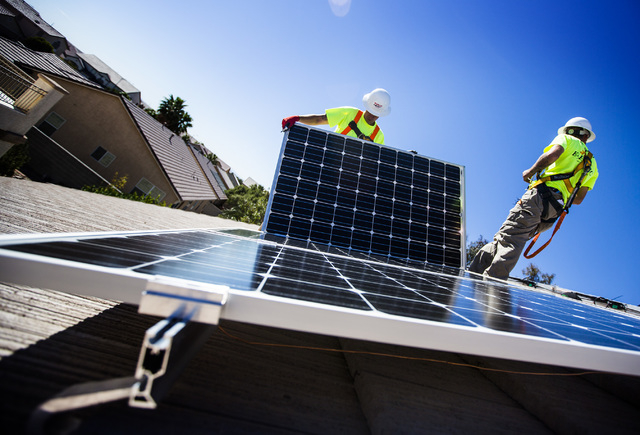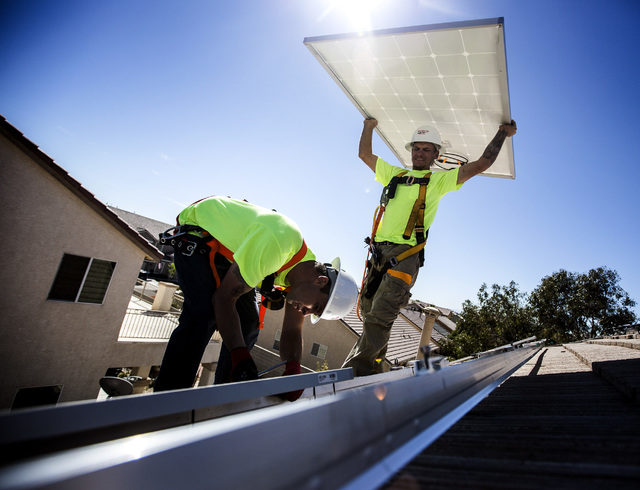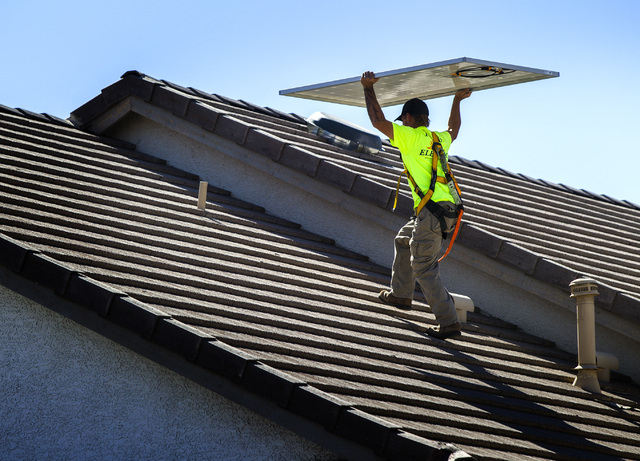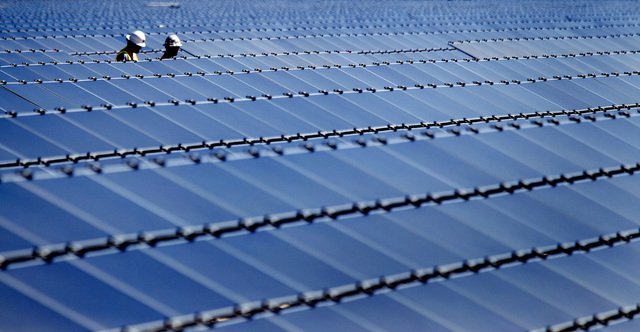Rooftop solar power grows despite waning incentives





Bill Wypyski wants to make a difference both in his wallet and in the world.
That’s why he installed his first solar array at his Las Vegas home in February.
“It’s the right thing to do for many reasons. You can have a debate on how much and how fast, but I’ll be saving money on electricity. It increases the value of the house. And people do influence the climate — all 6.5 billion of us. If I can do something in my little way of working positively, then I try to do it,” said Wypyski, a retired chemist.
Wypyski is still something of a pioneer: Small-scale solar remains a tiny share of Nevada’s power market. Just 70 megawatts of NV Energy’s 7,500-megawatt peak capacity statewide come from rooftop systems.
But thanks to consumers such as Wypyski, interest in home-based solar is skyrocketing. Applications for rebates through NV Energy’s SolarGenerations program have jumped tenfold since August, to about 1,000 per month. The 1,987 applications the utility received from January to mid-March dwarfed the 1,242 applications made in all of 2013.
Part of the surge comes from a more open application process and broadening of who can apply, said Stacey Kusters, the company’s vice president of renewable energy and orientation. But it also has to do with panel costs, down as much as 40 percent in recent years. Plus, a federal tax credit and NV Energy rebates are set to phase out in the next year or two, so consumers are grabbing deals while they can.
If you want your share, be prepared for a marketing blitz. Dozens of installation companies want your business, and some of them will say or do almost anything to ink a contract.
“There’s a lot of misinformation out there,” said Bruce Rogol, a photovoltaic project manager with Las Vegas-based Robco Electric, which installed Wypyski’s system. “It’s the first time the process has been really affordable, so people aren’t very knowledgeable about it.”
We’re here to change that.
A PLACE IN THE SUN
Before you even think about going solar, you need to know if you can.
If your roof faces north, forget about it. Your panels won’t see sunlight. Likewise, if your roof is broken up into multiple peaks and triangles — a common design for modern, Southwest-style homes — you might not have the rectangular roof expanse that solar panels need. Nor is a roof needing replacement in the next couple of years a good spot.
You can get around roofing troubles with a ground-mounted system, Rogol said, but those setups need a half-acre or more.
Shade over your roof could be a problem, too. You could add panels to compensate, but that’ll increase the cost.
Those technical details aren’t dealbreakers for most Southern Nevadans. Rogol can figure out a system for about 80 percent of the people who call him, he said.
The bigger problem is that it might not pencil out.
A common industry benchmark on whether solar makes financial sense is whether your power bill averages out to $100 a month or more. That’s not to say light power users can’t find affordable arrays. But whether you’re putting in a 2-kilowatt system or a 20-kilowatt system, you’ll spend about the same on infrastructure, equipment and labor, Rogol said. That can make it costlier per panel.
Even if solar might save money in the long run, you have to pay for it now. That’s the biggest obstacle for many consumers, but there are more ways than ever to cover the cost.
BANKING ON SUNSHINE
Traditionally, buying residential solar has meant plunking down thousands of dollars upfront.
But leasing models — led locally by California-based residential-solar giant SolarCity — have made big advances in the past three to five years, placing sun power within reach of many more consumers, said Tom Kimbis, vice president of the Solar Energy Industries Association.
Financing is still plentiful through home-improvement loans and home equity lines of credit, if you want to buy your system. The federal government offers a tax credit to cover 30 percent of the cost, and NV Energy rebates 40 cents per watt.
That knocks roughly $9,000 off of a $25,000 system, but the remaining $16,000 chunk is out of range for many.
Leasing can eliminate that upfront investment.
Essentially, you lease your roof to a solar provider. The provider installs and maintains photovoltaic panels, and you agree to buy back solar power over a period of time — typically 20 years. The provider captures tax credits and rebates, and passes along some savings to the homeowner. The agreement is designed to lower the overall power bill. Just as important, the provider requires no down payment.
Take a household with a $125-a-month bill averaged over a year. A typical SolarCity setup would charge that household about $70 a month, said Jonathan Bass, the company’s vice president of communications. That system would in turn cut the homeowner’s NV Energy bill to $40 a month. The total — $110 — would represent a 12 percent savings for the ratepayer.
With nothing down and a lower bill in the first month, “you start saving money immediately,” Bass said. “And you save over a longer period of time, rather than outlaying a larger amount over the front and seeing more savings at the back end of the system’s life.”
But Rogol, who sells the systems, notes that it can take five or six years for a purchased system to cover its cost in power savings but consumers who lease will pay for two decades. Nor do they get the full benefit of tax credits and rebates.
That was Wypyski’s thinking when he chose to buy, rather than lease, his system, which cost roughly $21,000 before rebates and tax credits.
“You’re just paying the solar company for the electricity, and they get the benefits of the rebate,” he said. “And you end up signing a 20-year lease. Suppose you want to sell your house 10 years down the line. You’ve narrowed the potential buying public because you’re going to have to talk someone into picking up the lease.”
The Solar Energy Industries Association doesn’t give either model preference.
“But leasing really has opened up solar to a lot of folks who could not pay that first cost,” Kimbis said. “If you’re buying a system, you’re basically paying cash up front for all of the power that electric system will produce over its lifetime, which sometimes can go past 30 years. That can be an expensive proposition. For people who don’t have a lot of cash reserves, third-party ownership models allow them to put solar on their roof and reduce their bills. It’s a very popular option.”
In either case, you’ll still pay a monthly power bill. Your system won’t work overnight or on cloudy days, and you have to cover NV Energy’s basic service charge to stay connected to the grid.
If all of that is cool with you, your next step is to choose a responsible installer or provider.
NOT RIGHT FOR ALL
Getting your system installed properly can make all the difference in how — or whether — your array works. A panel not set properly in its tracker can throw off the performance of an entire system, Kusters said.
Choosing a company can be tough. An online search yields more than a dozen local businesses that say they sell or lease panels, exclusive of the constant stream of phone and email pitches exhorting, “Go solar now!”
Your best bet is to begin your search by tossing out companies making claims that sound too good to be true. Going solar isn’t “free,” and it won’t “eliminate your power bill.” Nor will your digital meter ever “spin backward.”
Also, look for businesses that suggest conservation measures first. As power-industry experts say, the cheapest kilowatt is the one you never use.
Consider a home with an older air-conditioning unit and incandescent light bulbs.
You could buy a system that will cover 100 percent of your power use. But if your AC unit is old and you buy a new model that’s 30 percent more efficient, you’ve overpaid for a system you don’t need, Rogol said. Ditto with lighting: By swapping out incandescent bulbs with light-emitting diode versions, you can cut your power bill by 10 percent.
“A 50 percent system today can cover 100 percent of your use in a couple of years with some changes in the home,” Rogol said.
Kimbis recommends the “same level of due diligence you’d do with any contractor performing major home-improvement work.”
That means getting multiple bids, checking histories with groups such as the Better Business Bureau and asking neighbors with solar for recommendations.
Be sure you ask a lot of questions. If a salesman can’t answer, he may not understand what he’s trying to sell, Rogol said.
For Wypyski, self-education was key.
“There are all sorts of resources on the Internet today, and learning a little bit about solar allows you to ask the right questions,” he said.
Because of his advance research, Wypyski said, he knew more than the sales representative of the first company who gave him a bid. Wypyski nixed that firm and eventually went with Robco.
Plus, most reputable companies offer performance guarantees.
SolarCity’s smartphone app tells customers in real time how much solar they’re producing and power they’re using. They can change behavior to cut use, and if the system underperforms, SolarCity will investigate and fix it. The company also compensates customers for under-performance, Bass said.
All you should have to do once you have solar is hose down your panels when they get dusty.
Your system should be warrantied — a typical industry warranty runs at least 20 years — and you should try to get a hunch for whether the installer will be around in a few years if something goes wrong. If you lease, the provider should be willing to repair components at little or no cost. Check your contract before you sign.
THE PAYOFF
So will solar remain a good deal for consumers who can swing a purchase or lease?
Industry views are mixed.
The Solar Energy Industries Association and other trade groups are looking to extend the federal tax credit beyond its Dec. 31, 2016, expiration date. It’s not clear they’ll be able to.
What is clear is that NV Energy is closing in on the incentive limits it’s allowed under a 2003 state law. The utility started a decade ago with a rebate of $5 per watt, but as panel prices have dropped, the rebate has fallen to 40 cents a watt. It’s set to decline to 20 cents in coming months, and then go away altogether in the next year or two, based on the principle that it’s not fair for ratepayers who may not be able to afford some of the upfront cost of solar to subsidize systems for those who can.
“Absent the net-metering subsidy, rooftop solar doesn’t make sense,” Kusters said, though she added that some consumers will continue to embrace solar “purely because they believe in renewable energy.”
Rogol said he expects business to soften as incentives disappear. Still, he said he expects long-term upward pressure on rates, especially as NV Energy looks to replace its coal-powered plants with pricier natural gas and renewable energy, though NV Energy officials have said they’ll look to existing generation rather than build new to replace coal capacity.
At the same time, the costs of solar equipment and financing continue to drop, even as less than 1 percent of U.S. households have residential rooftop solar, Bass said.
“I think there’s a lot of room to drive out additional costs. The big advantage with solar is that the fuel source is free. Unlike natural gas or petroleum, the fuel falls from the sky. We just have to collect it. Also, SolarCity has created some economies of scale, but there’s a lot more room for growth there as well. We’re really at the beginning of the curve in solar.”
Wypyski hasn’t seen savings yet, because he’s still waiting for NV Energy to change the meter on his system. But he said he’s looking forward to watching his summertime bill drop to a fraction of its typical $225-a-month charge.
“It will pay for itself. It’s just a question of when.”
Contact Jennifer Robison at jrobison@reviewjournal.com. Follow @J_Robison1 on Twitter.
Solar true or false?
In the scramble for business before incentives expire, some solar providers make questionable claims. We’ve fact-checked a few:
You can switch for free. True, sort of. Technically, this is right if you’re working with a third-party provider. The problem is, some companies make it sound like solar will cost you nothing. You can find someone who’ll install your system for free, but you’ll at least have a monthly lease payment. Ignore anyone who tells you otherwise.
You’ll be energy-independent. False. No residential NV Energy customer has managed to escape the grid completely. Because residential solar arrays lack energy storage, you’ll need to tap conventional generation overnight, said Stacey Kusters, vice president of renewable energy and origination for NV Energy.
It will eliminate your power bills. False. Even if you could zero out your monthly NV Energy use, you’d still owe a monthly basic service fee for staying connected to the grid. You’d also need to keep paying NV Energy charges related to energy-efficiency programs.
“Some of the parties selling solar systems would like the buyer to be convinced that once you put solar on your roof, essentially, you’re getting power for nothing,” Kusters said. “But you are still going to get a bill from NV Energy.”
Watch out for these related falsehoods: The provider will pay you each month, or you won’t need to rely on the power company.
You get paid for excess power you produce. False. NV Energy does not pay you for power you feed into the grid. It issues you credits to put toward use during peak periods or overnight. Besides, state law doesn’t allow you to install a system with a capacity that’s more than 100 percent of your household’s use, so you’ll probably never be in a position where your generation exceeds your needs anyway.
Solar increases your home’s value. True, in many cases. There’s evidence, though, that leased systems may not pack the same appraisal punch. A 2014 report from National Public Radio quoted home-appraisal experts as saying leased systems could be a turn-off for some buyers who have to assume them.
Big solar providers are addressing this issue. SolarCity has a dedicated team to help customers sell their home with its leased solar array. The team analyzes past and future savings for prospective buyers.
“We can say, ‘Here’s your benefit. There’s no additional cost for the house, but you’re paying a lower energy bill because you’ve got solar,’” said Jonathan Bass, the company’s vice president of communications.
Germany gets up to 50 percent of its energy from solar, so why can’t we? False. This rumor is based on a handful of peak-use days in recent years in which solar power in Germany handled much of the load. Spread out 24-7 over a year, though, solar power made up just 6 percent of overall German generation in 2012, according to trade magazine Renewables International. That number was set to head south as feed-in tariffs and other incentives phased out.
Power bills in Nevada have risen 5 percent/10 percent/20 percent a year in recent years. False. According to numbers from the U.S. Energy Information Administration, residential power rates in Nevada have held mostly steady in recent years. They even declined with fuel prices for a period. The average price per kilowatt hour statewide was 12.99 cents in 2009, and 12.95 cents in December. In 2011, they slipped to 11.08 cents as utilities passed along savings from plummeting prices for the natural gas that powers their plants.
What is true is that prices are up roughly 20 percent over the past decade: The average was 10.81 cents in 2005. The decade-long increase comes largely from NV Energy’s effort to build its own generation — an initiative completed during the recession.
If you go solar, it will reduce American dependence on foreign oil. False. No electric power generated in Nevada comes from oil. The mix is mostly natural gas, some renewables and a small amount of coal.
Solar energy is 100 percent clean and creates zero waste. Half-true. The generation of solar power produces no pollution, byproduct or emission of greenhouse gases.
The panel-manufacturing process is a different story. It requires mining materials such as silica, silver and rare-earth materials such as indium. It also requires use of potentially toxic chemicals and greenhouse gases, including silane gas and sulfur hexafluoride. And some makers use lead-based solders — a problem come disposal time. There are also greenhouse-gas emissions from shipping.












